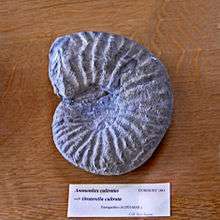Oosterellidae
| Oosterellidae Temporal range: Cretaceous, 145.5–130.0 Ma | |
|---|---|
 | |
| Fossil of Oosterella cultratus from Maritime Alps, on display at Galerie de paléontologie et d'anatomie comparée in Paris | |
| Scientific classification | |
| Kingdom: | Animalia |
| Phylum: | Mollusca |
| Class: | Cephalopoda |
| Subclass: | Ammonoidea |
| Order: | Ammonitida |
| Suborder: | Ammonitina |
| Superfamily: | Perisphinctoidea |
| Family: | Oosterellidae Kilian, 1911 |
Oosterellidae is an extinct ammonoid cephalopod family belonging to the superfamily Perisphinctoidea. These fast-moving nektonic carnivores lived during the Cretaceous.[1]
Genera
- Oosterella
- Pseudoosterella
Distribution
Fossils of species within this genus have been found in the Cretaceous sediments of Argentina, Austria, Colombia, Czech Republic, France, Hungary, Italy, Mexico, Morocco, Romania and Slovakia. [1]
References
This article is issued from Wikipedia - version of the 10/25/2016. The text is available under the Creative Commons Attribution/Share Alike but additional terms may apply for the media files.